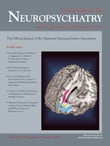SIR: Tardive dystonia is a delayed side effect of antipsychotic exposure that occurs at a frequency of 1% to 4.0%.
1 Most reports of tardive dystonia are from first-generation antipsychotics with recent case reports involving risperidone,
2 olanzapine,
3 and possibly clozapine. A MEDLINE/PubMed/Psylit search did not reveal any published reports of tardive dystonia associated with second-generation antipsychotics available in the United States, such as ziprasidone, quetiapine, or aripiprazole. We report a case of tardive dystonia following the addition of aripiprazole to a patient’s medication regimen.
A 35-year-old Caucasian woman diagnosed with schizoaffective disorder—bipolar subtype, panic disorder, and alcohol abuse was stable for a year on ziprasidone (160 mg), topiramate (300 mg), trazodone (100 mg hs) and temazepam (15 mg prn) for insomnia. She was hospitalized because of a relapse of psychotic, depressive, and panic symptoms. She was treated with clonazepam for panic and venlafaxine for depression. The dose of ziprasidone was increased to 200 mg/day with minimal improvement in psychotic symptoms. Aripiprazole was started and the dose titrated to 30 mg before the psychotic symptoms resolved completely. Discharge medications were ziprasidone (200 mg), aripiprazole (30 mg), clonazepam (3 mg), benztropine (2 mg), venlafaxine XR (225 mg), topiramate (300 mg), temazepam (30 mg), and trazodone (100 mg) a day.
Eight weeks after discharge she presented with 1 week of an inability to stand upright, being bent to the right, a mild degree of pain in the thoracic area, and significant emotional distress. Examination showed dystonic scoliosis of the thoracic spine with convexity to the left. No other muscle group was involved. There was no rigidity or involuntary movement in other parts of the body. She had a mild degree of akathisia. She had a history of normal birth and no associated medical problems. Aripiprazole was stopped while continuing all other medications. Within a week, akathisia subsided and in a month there was substantial improvement in dystonic symptoms. Three months later she remained free of dystonic symptoms.
The above clinical presentation satisfies the diagnostic criteria for tardive dystonia by Burke et al.
4 This case reminds us that despite its name, tardive dystonia is characterized more by the chronic nature of the dystonia than by the duration of antipsychotic exposure and is known to occur weeks or even days after use of antipsychotics.
4 Medications that could be implicated in tardive dystonia in this patient are ziprasidone, aripiprazole, venlafaxine, and trazodone. A drug-interaction software did not reveal any drug interaction relevant to this case. Trazodone and ziprasidone
5 have been associated with acute but not tardive dystonias. There are no reports of dystonia with venlafaxine. The dystonia, occurring 8 weeks after adding aripiprazole, showing dramatic improvement after stopping aripiprazole despite continuing ziprasidone and trazodone, makes aripiprazole the possible etiological agent. We cannot be sure if monotherapy with aripiprazole could have caused dystonia and prior treatment with antipsychotics may have predisposed the patient to developing tardive dystonia with addition of aripiprazole. Clinicians should realize that although monotherapy has a much lower incidence of extrapyramidal symptoms, when combined with second generation antipsychotics, like aripiprazole, they are not devoid of them. This includes symptoms of tardive dystonia.

